Anti-aircraft guns against tanks. Part 5
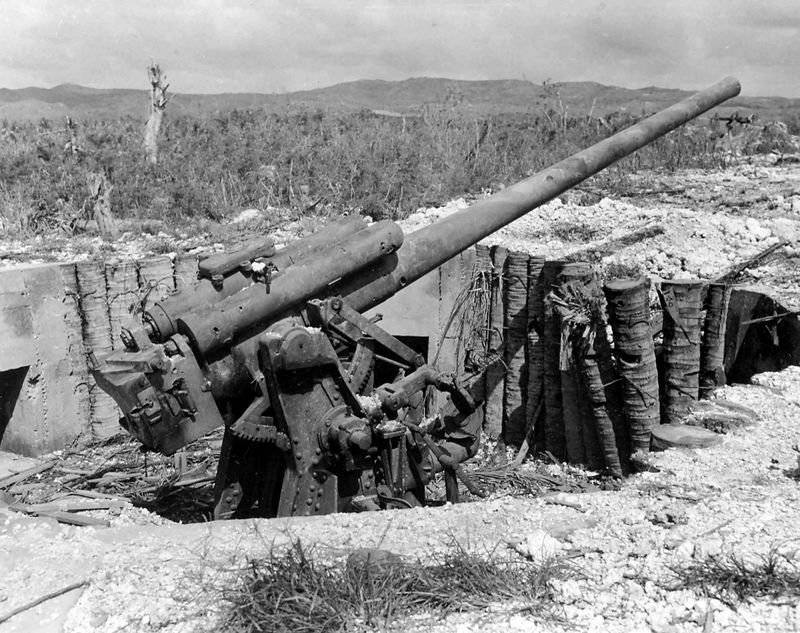
Considering the Japanese anti-aircraft weapons available in the army and on navy during the Second World War, it can be noted that most of it did not meet modern requirements. This was partly explained by the weakness of Japanese industry and a lack of resources, partly by a misunderstanding by the Japanese command of the role of anti-aircraft artillery. The situation was aggravated by the large heterogeneity of the available models. The Imperial Army of Japan and the fleet were armed with guns of different years of development with non-matching calibers.
In the 1938, the Japanese army adopted the automatic 20-mm gun Type 98. According to its design, she repeated the French machine gun “Hotchkiss” arr. Xnumx this weapon originally developed as a dual-use system: to combat lightly armored ground and air targets.
The first modification of the gun had wooden wheels with knitting needles for transporting horse carriage or a truck. At the position of the gun mounted on the legs of the bed, which divorced, forming two rear supports, in addition to the third, front. After the final installation of the legs of the tripod (for the calculation of the 2-3 man, this process took 3 minutes), the gunner-gunner was located on a small seat. It was possible to shoot directly from the wheels, but in the process of shooting the gun became unstable and the accuracy deteriorated seriously. A variant was later created, parted and transported in packs.
The 20-mm gun Type 98 used a fairly powerful projectile - the same as the type gun 97. At a distance of 245 m he punched armor with a thickness of 30 mm. The initial speed 162 g armor-piercing projectile - 830 m / s. Reach height - 1500 m. Weight in the combat position of the version with a wheel - 373 kg. The power was supplied from the 20 of the charging shop, which limited the practical rate of fire (120 rds / min). Total Japanese industry has managed to transfer to the troops around 2500 Type 98. In addition to single-barrel installations, the twin version of the Type 4 was produced. Before the end of hostilities, around 500 20-mm sparks were transferred to the troops.
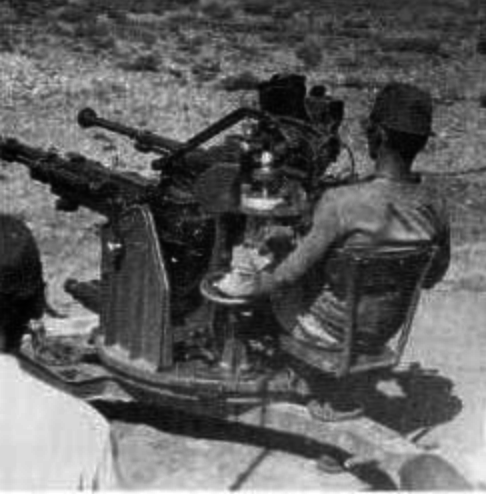
As part of military-technical cooperation, the Germans handed over technical documentation and full-scale samples of the 20-mm anti-aircraft machine Flak 38. In 1942, the 20-mm anti-aircraft gun under the Japanese name Type 2 began to enter the army. Compared to Type 98, the copy of Flak 38 turned out to be faster, more accurate and reliable. The rate of fire increased to 420-480 shots / min. Weight in the combat position: 450 kg.
At the end of 1944, the mass production of the twin version of the German licensed 20-mm machine began. But due to the limited capacity of the Japanese industry to produce a significant number of such installations failed.
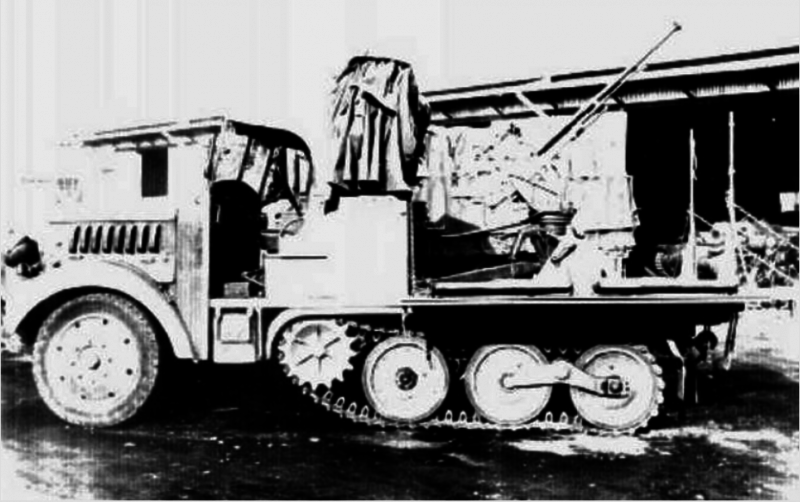
In Japan, attempts were made to create a ZSU by installing 20-mm anti-aircraft guns on light Tanks, various semi-tracked conveyors and trucks. Due to the insufficient number of self-propelled chassis and the chronic shortage of anti-aircraft guns in the troops, Japanese ZSU were produced in very small quantities.
20-mm anti-aircraft systems are very actively used in combat operations on land. Disassembled, easily portable and masked 20-mm guns Type 98 brought a lot of problems to the Americans and the British. Very often 20-mm machines were mounted in bunkers and sweep the terrain for a kilometer. Their shells represented a great danger for airborne landing craft, including for light armored LVT amphibians and fire support vehicles based on them.
25-mm anti-aircraft gun Type 96 has become the most famous Japanese anti-aircraft gun. This automatic anti-aircraft gun was developed in 1936 year on the basis of the gun of the French company "Hotchiss". It was widely used during the Second World War, being the main light anti-aircraft weapon of the Japanese fleet, but it was also available in the Imperial Army. The power supply of the machine was carried out with the help of magazines on 15 cartridges inserted from above. Practical rate of fire - 100 — 120 shots / min. Total weight: 800 kg (single), 1100 kg (paired), 1800 kg (built). The initial velocity of the projectile 262 g - 900 m / s. Effective firing range - 3000 m. Reach height - 2000 m.
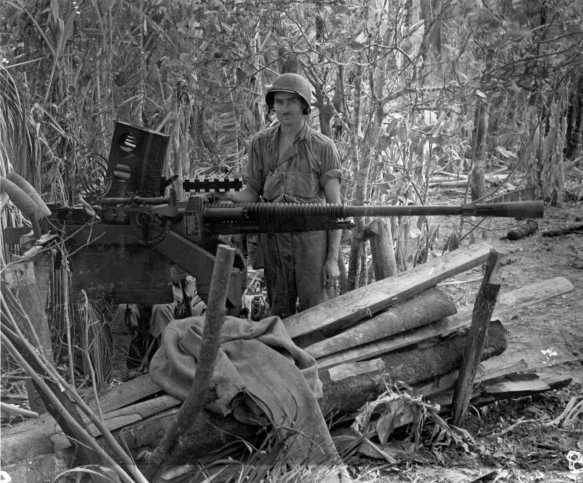
The 96 type was used in single, paired and structured installations, both on ships and on land. Over the years, more than 33000 25-mm guns have been produced. Until the middle of the 1930-s, the 25-mm 96 Type anti-aircraft guns were quite satisfactory weapons. But during the war revealed significant shortcomings. Practical rate of fire was low, optimal for weapons of this caliber would be tape power. Another drawback was the air cooling of gun barrels, reducing the duration of continuous firing.
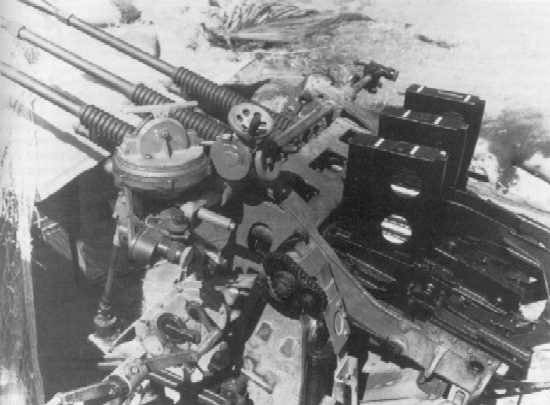
When used on the coast, 25-mm anti-aircraft guns posed a mortal danger to lightly armored floating conveyors and fire support vehicles based on them. American light tanks "Stewart" repeatedly suffered heavy losses from the fire Type 96.
After the Japanese occupation of a number of British and Dutch colonies in Asia, a significant amount of 40-mm Bofors L / 60 anti-aircraft guns and their ammunition fell into their hands. These captured anti-aircraft guns were very actively used by the Japanese army against the British and American aviation, and after the start of the American landing operations, in coastal and anti-tank defense.
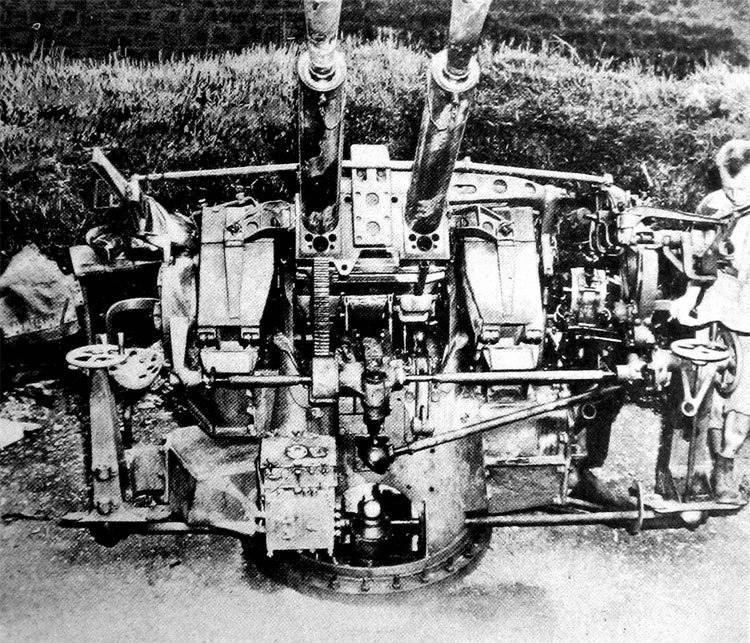
Former Dutch naval anti-aircraft installations Hazemeyer, with paired 40-mm "Bofors", were permanently installed on the coast and were used by the Japanese to defend the islands.
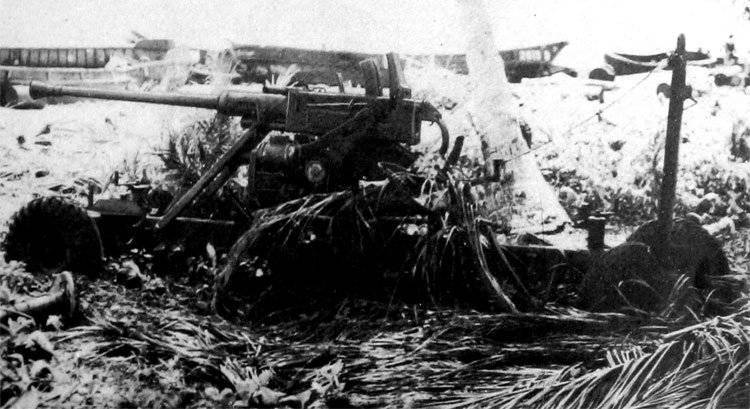
In 1943, in Japan, an attempt was made to copy and launch the 40-mm Bofors L / 60 automatic machine under the name Type 5. However, the lack of technical documentation and the low quality of metalworking did not allow for the mass production of anti-aircraft installations. From 1944, the 5 Type was assembled by hand at Yokosuka Naval Arsenal at the rate of 5-8 gun production per month. Despite the manual assembly and individual fitting of parts, the quality and reliability of Japanese 40-mm anti-aircraft guns, designated the Type 5, were very low. Subsequently, after the war, American engineers, familiarized with captured 40-mm Japanese-made anti-aircraft guns, were greatly perplexed how the automatics functioned with this quality of production. Several dozen of these anti-aircraft guns, which were available to the troops because of their small size and unsatisfactory reliability, did not have any effect on the course of the hostilities.
The first specialized medium-caliber anti-aircraft gun in the Japanese armed forces was the 75-mm anti-aircraft gun Type 11, which entered service in the 11 year of Emperor Taisho (1922 year). The tool was a conglomerate of foreign borrowing. Many of the details were copied from the British 76,2-mm anti-aircraft gun QF 3-in 20cwt.
Due to the lack of experience, the weapon turned out to be expensive and difficult to manufacture, and the accuracy and firing range turned out to be low. Reach height at an initial speed of 6,5-kg 585 projectile m / s was about 6500 m. A total of 44 anti-aircraft guns of this type were produced. Due to their small size, they had no influence on the course of the war, and by the year of 1943 were written off due to wear.
In 1928, 75-mm anti-aircraft gun Type 88 (2588 year "from the foundation of the empire) was launched into production. Compared to the Type 11, it was a much more sophisticated weapon. Although the caliber remained the same, it exceeded the 11 Type in accuracy and range. The gun could fire targets at heights up to 9000 m with a rate of 15 shots / min.
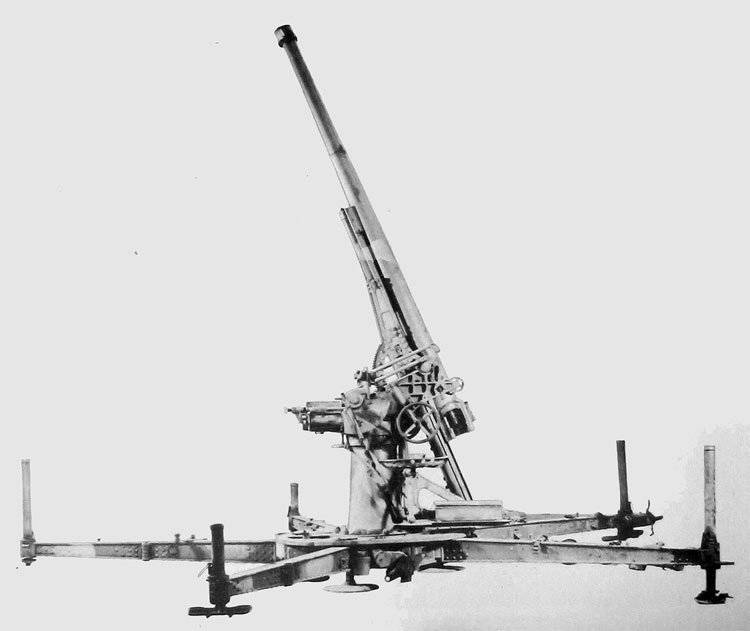
At the end of the 30-x gun Type 88 no longer fully met modern requirements, in terms of range, height of destruction and the power of action of the projectile. In addition, the procedure of deployment and coagulation of anti-aircraft guns in a combat position caused many complaints.
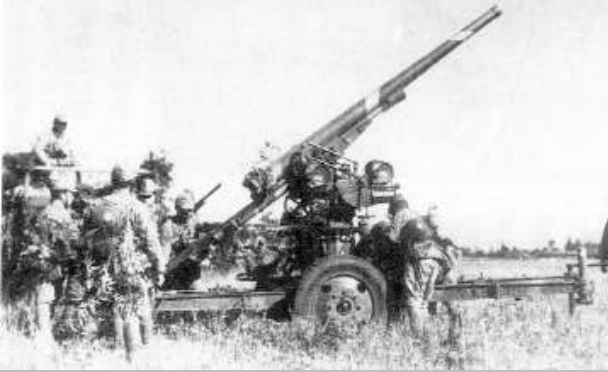
Difficult and time-consuming procedures for dismantling two transport wheels, pushing apart four of the five radial supports and centering the jacks physically exhausted the calculations and took an inadmissibly long amount of time.
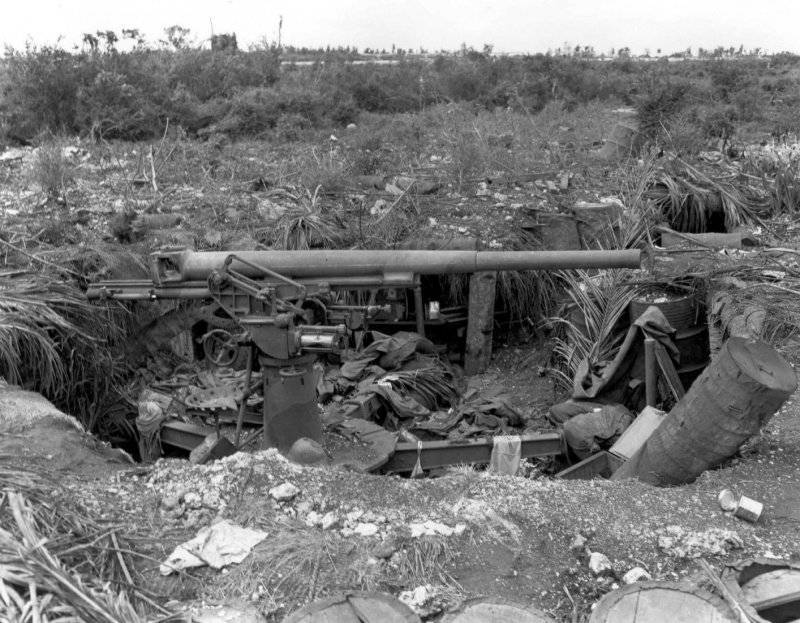
The Japanese command viewed 88 Type guns as an effective means of VET. Especially a lot of 75-mm anti-aircraft guns were installed on the line of fortifications on Guam. However, these hopes did not come true. Theoretically, 75-mm anti-aircraft guns could pose a great threat to the American Shermans, but before landing the American assault forces on the Pacific islands, the coastal zone was so carefully and generously processed by assault aircraft and ship artillery shells that had little chance of surviving.
At the end of 1943, the small-scale production of 75-mm anti-aircraft guns Type 4 began in Japan. According to their characteristics, they exceeded the Type 88. The height of the fired targets increased to 10000 m. The gun itself was more technologically advanced and convenient to deploy.
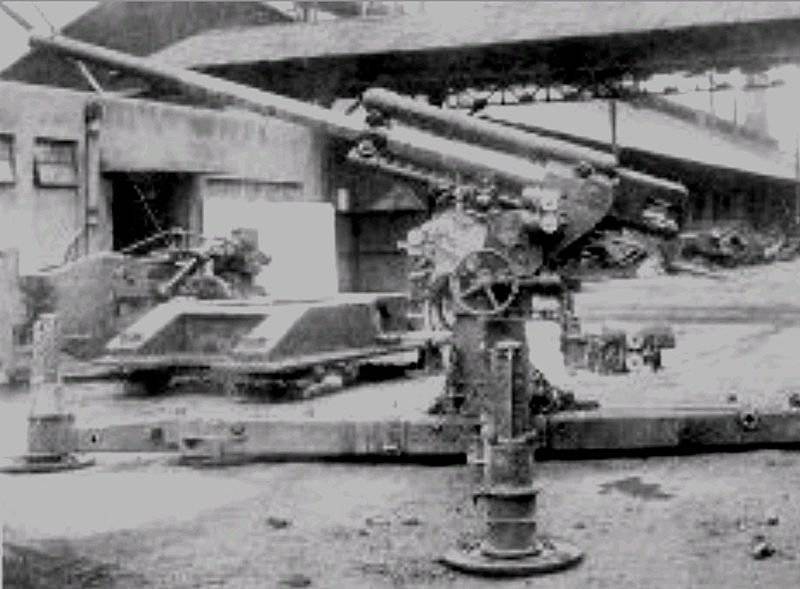
The prototype for the Type 4 was the 75-mm Bofors M29 cannon, captured during the fighting in China. Due to the incessant raids of American bombers and the chronic shortage of raw materials, it was possible to produce only about 70 75-mm anti-aircraft guns Type 4.
During the First World War, the 76,2-mm semi-automatic weapon Type 3 was adopted by the Imperial fleet to arm auxiliary warships and protect cruisers and battleships from the mine fleet and aircraft. The guns had a reach of 7000 meters in altitude and 10-12 firing rates / min.
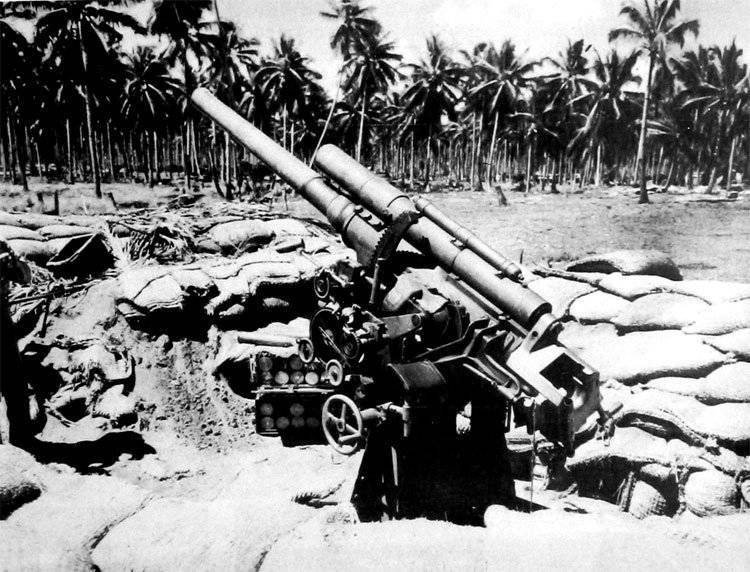
By the middle of the 30-x the main part of the "dual-purpose" 76-mm guns moved from the ship's decks to the shore. This circumstance was due to the fact that outdated guns, which did not have effective anti-aircraft fire control devices and were capable of firing only barrage, were replaced with 25-mm machine guns. As an anti-aircraft guns Type 3 themselves absolutely did not show, but then took an active part in the battles 1944-1945 years in the role of coastal and artillery.
Another anti-aircraft gun created on the basis of the trophy sample was the Type 99. The German-made naval gun became a role model for creating the 88-mm anti-aircraft guns. Realizing that 75-mm anti-aircraft guns Type 88 no longer fully meet modern requirements. The Japanese military leadership decided to launch the captured weapon into production. Gun Type 99 entered service in 1939 year. From 1939 to 1945, the year produced about 1000 guns.
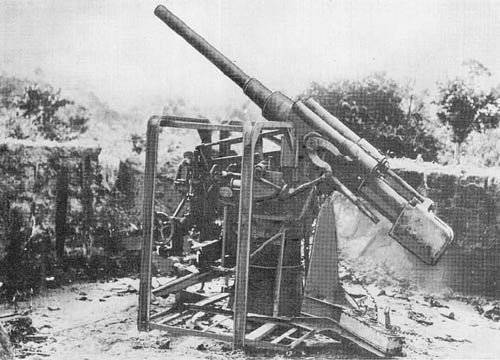
Gun Type 99 significantly superior to the Japanese 75-mm anti-aircraft guns. A fragmentation projectile weighing 9 kg left the barrel at a speed of 800 m / s, reaching a height of more than 9000 m. Fighting rate of fire was 15 rds / min. An obstacle to using the Type 99 as an anti-tank was the fact that the anti-aircraft gun did not develop a carriage convenient for transportation. In the case of redeployment, the weapon was dismantled, so 88-mm anti-aircraft guns, as a rule, were placed in stationary positions along the coast, simultaneously performing the functions of coastal defense guns.
In 1929, 100-mm anti-aircraft gun type 14 (14-th year of Emperor Taisho) was put into service. The height of the hit targets 16-kg shells Type 14 exceeded 10000 m. The rate of fire to 10 shots / min. The mass of the gun in the combat position of about - 6000 kg. The frame of the gun rested on six sliding legs, which were leveled with jacks. For undoing the wheel travel and transfer of anti-aircraft guns from the transport to the combat position, the calculation required the smallest 45 minutes.
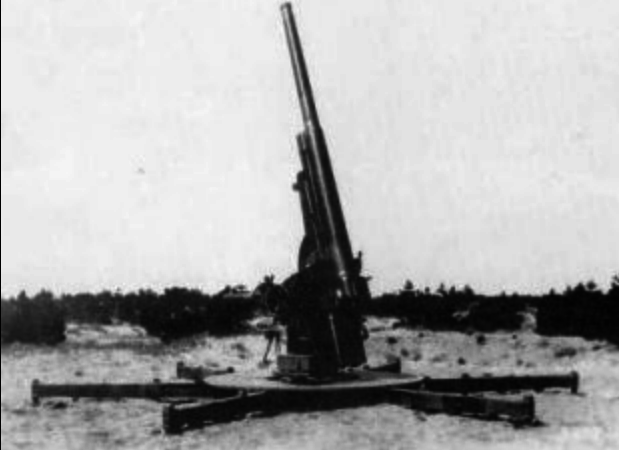
In the 30s, the advantage of the combat performance of the 100-mm guns of the 14 Type over the 75-mm Type of the 88 was not obvious, but they themselves were much heavier and more expensive. This was the reason for the removal of 100-mm guns from production. Total armed consisted of about 70 guns Type 14.
One of the most valuable combat types of anti-aircraft installations, pumping from deck to shore, was the 100-mm gun mount type 98. Prior to that, 100-mm guns were mounted on destroyers of the "Akizuki" type. For arming large ships, the semi-open installation Type 98, model A1, was developed, it was used on the Oydo cruiser and Taiho aircraft carrier.
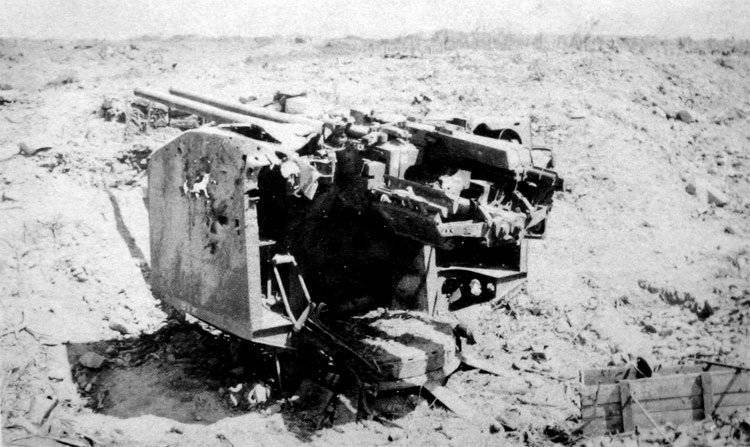
The Japanese command, faced with an acute shortage of air defense and coastal defense weapons, at the beginning of 1944 of the year ordered the installation of existing weapons intended for unfinished warships to land stationary positions. 100-mm semi-open twin installations Type 98 proved to be a very powerful means of coastal defense. Most of them were destroyed as a result of targeted air strikes and artillery shelling.
Shortly after the start of raids by American bombers on the Japanese islands, it became clear that the capabilities of the existing 75-mm anti-aircraft guns were not enough. In this connection, an attempt was made to launch the X-NUMX-mm German gun Flak 105 from Rheinmetall into serial production. They were quite sophisticated for their time guns, capable of firing targets at heights above 38 m. In parallel, a heavy anti-tank gun Type 11000 was created, the use of which was planned both in towed and self-propelled version. The Japanese industry until the end of hostilities could produce only a few prototypes, and the matter did not come to real adoption of 1-mm guns. The main reasons were the shortage of raw materials and the overload of enterprises with military orders.
The 120-mm gun Type 10 (10 is the year of the emperor Taisho) was widely used for the defense of the islands. It entered service in 1927 year and was developed on the basis of the sea as an instrument of coastal defense and anti-aircraft. Many already built naval guns were redone to anti-aircraft. In total, onshore units in 1943 there were more than 2000 type 10 guns.
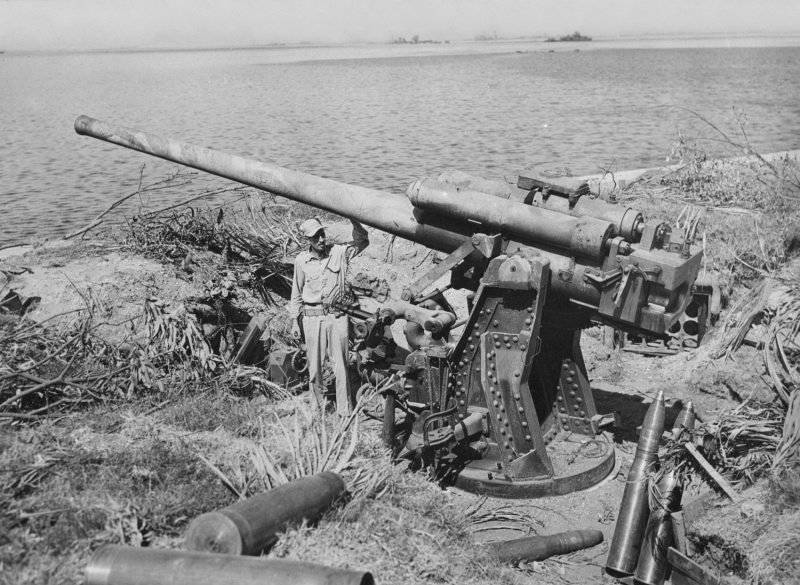
A gun weighing about 8500 kg was installed in stationary positions. Rate of Fire - 10-12 rds / min. The initial velocity 20 kg projectile - 825 m / s. Reach height 10000 m.
The leadership of the Japanese Imperial Army had high hopes for the new 120-mm anti-aircraft gun Type 3, which was to change the 75-mm anti-aircraft guns in mass production. Anti-aircraft gun Type 3 was one of the few guns in the air defense of Japan, which could effectively bombard the B-29 bombers that carried out destructive attacks on cities and industrial enterprises in Japan. But the new weapon turned out to be excessively expensive and heavy, its weight was close to 20 tons. For this reason, the release of guns Type 3 did not exceed 200 units.
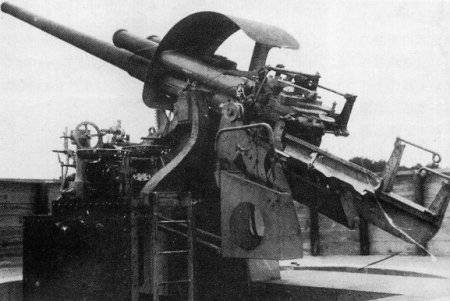
Another sea instrument forcedly used ashore was 127-mm Type 89. The guns in the mass position of more than 3 tons were installed in stationary fortified positions. A projectile weighing 22 kg with an initial speed of 720 m / s could hit air targets at altitudes up to 9000 m. Firing rate - 8-10 shots / min. Part of the guns in the two-half-closed towers, protected by fragmentation armor, was mounted on concreted positions.
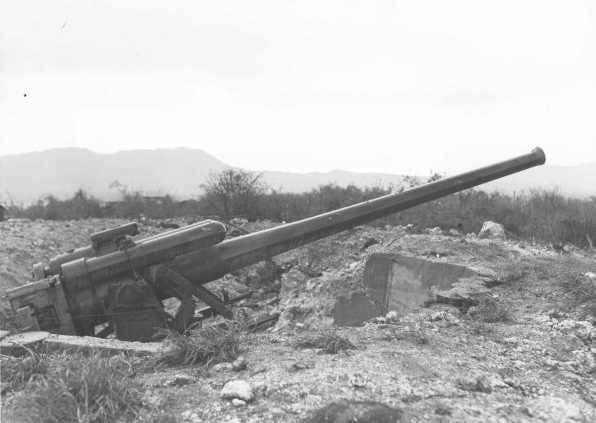
After the start of regular raids by American bombers, the Japanese command was forced to attract naval guns, removed from damaged or unfinished vessels, to reinforce the air defense of ground objects. Some of them were located in capital positions in closed or half-open towers, as a rule, not far from the naval bases or close to places convenient for the landing of the amphibious assault forces. All anti-aircraft guns, in addition to their direct purpose, were tasked with coastal and antiamphibious defense.
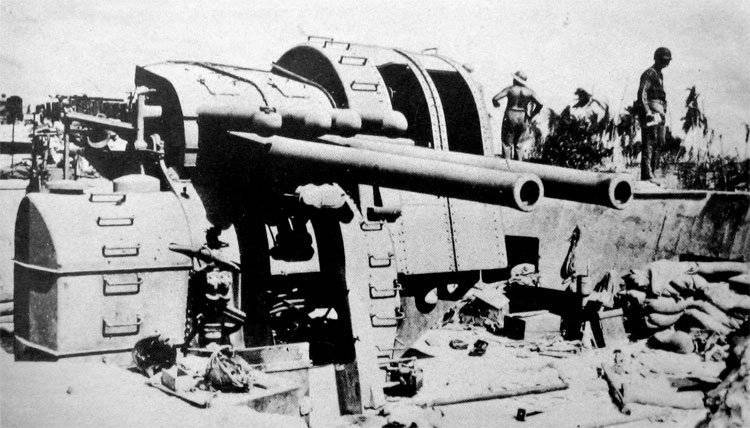
In addition to the Japanese naval guns, captured anti-aircraft guns were also widely used on the coast, including those raised from sunken ships in the shallows of American, British and Dutch ships. The Japanese Imperial Army used British 76,2-mm anti-aircraft guns QF 3-in 20cwt captured in Singapore, American 76,2-mm anti-aircraft guns M3, Dutch 40 and 75-mm "Boforsa". Those that survived to 1944, were used in the antiamphibious defense of the Pacific Islands captured by Japan.
A large variety of types and calibers of Japanese anti-aircraft guns inevitably created problems with the preparation of calculations, the supply of ammunition and the repair of guns. Despite the presence of several thousand anti-aircraft guns prepared by the Japanese for firing at ground targets, it was not possible to organize an effective anti-airborne and anti-tank defense. Much more tanks than from the fire of the Japanese anti-aircraft artillery, the US marines lost drowned in the coastal zone or hit by mines.
Based on:
http://www.navweaps.com
http://zonwar.ru/index.html
http://alternathistory.com/neletayushchie-frantsuzskie-aviapushki-gochkiss-i-ko
http://www.navweaps.com/
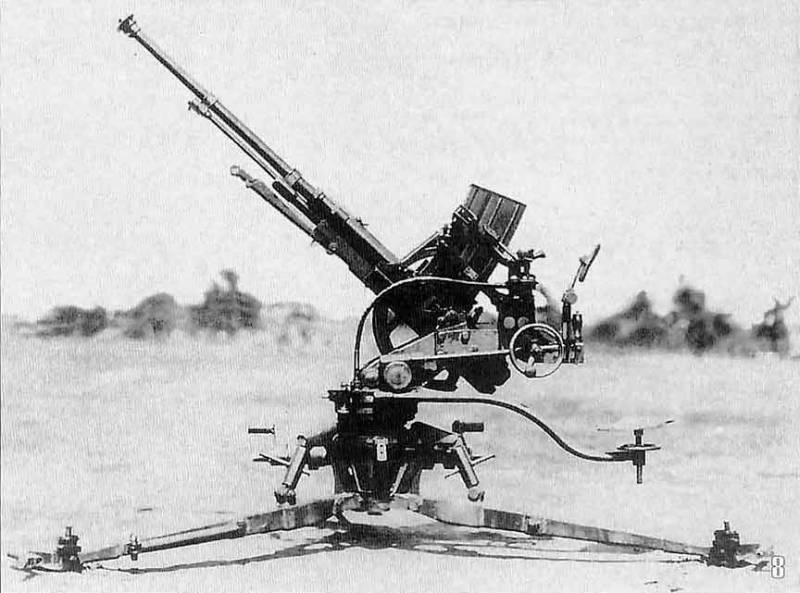
Information